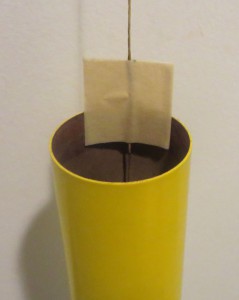Kevlar
KEVLAR SHOCK CORDS
When I started building rockets in the late 1960s, rubber band stock was the standard shock cord material. Most was 1/8″ wide x 12″ to 18″ long. It was the same type of rubber used in rubber band powered model airplanes. You can still buy it in bulk from www.sigmanufacturing.com
Many kits use a shock cord “Tri-Fold” mount. But, the Tri-Fold mount is bulky and can block ejection of a parachute in a small body tube.
Today, strong Kevlar thread is attached to the engine mount. A length of elastic is tied to the end of the Kevlar. The elastic is then tied to the screw eye in the nose cone.
Using the Kevlar/Engine mount, nothing blocks the parachute’s passage through the body tube. Some modeler’s only use a very long length of Kevlar, 3 times the body tube length. I use the combination of Kevlar (just short of the body tube end) and 1/8″ or 1/4″ x 36″ of elastic.
A Kevlar shock cord line is said to be 4x stronger than steel.
60 lb. Kevlar is .016″ in diameter. It is good for small and Micro Maxx models.
100 lb. Kevlar is the standard for low power rocketry. It is right around 0.024″ in diameter. In the thread industry it is designated as size 300. 100 and 150 lb. Kevlar should be fine for most all low powered sport rocketry.
400 lb. Kevlar (.060 diameter) should be reserved for larger models.
Much has been written about how to prevent “Zippers”. Zippers occurs when the kevlar cord cuts thru the upper body tube at ejection.
When an ejection is too early or too late, (not at apogee) the model has not slowed down. Ejection happens while the model is moving too fast. The increased velocity and snap back of the nose cone and parachute can pull back on the Kevlar cord and cut through the body tube.
Some tie a loop in the Kevlar, just short of the end of the upper body tube. The Kevlar can’t reach beyond the body tube end so no zipper can happen. Notice the Super Glue (CA glue) reinforced tube edge.
To tie the Kevlar loop, mark the line below the top of the body tube. Push the Kevlar out the back of the model, through the engine mount. Tie the elastic on, then feed the elastic and Kevlar back through the rocket an out the top. The elastic shock cord then ties to the screw eye on the nose cone.
Some use only a very long length of Kevlar for a shock cord. Wrap masking tape over the line where it touches the body tube edge. Center and fold a few wraps of tape over the Kevlar.
The folds of tape spread out and absorbs any “snap-back” shock preventing the zipper. Instead of the folded tape, some use rubber tubing. This tubing is gas “fuel line” for small gas engine airplanes.
Reinforcing the body tube edges the Super Glue helps. But under so much pressure, Kevlar cord can cut through just about anything.
Kevlar can burn through over time. Ejection charges eventually break down the thread. Kevlar has a burning temperature of 600 degrees f.
ELASTIC SHOCK CORDS
At the end of the Kevlar, the elastic shock cord is tied. Most use a shock cord that is three times the length of the model. The shock cords supplied in kits are usually too short.
A longer shock cord can prevent dents in a nose cone when it snaps back towards the body tube.
Example: A 12″ tall rocket could use 36″ of elastic, but that’s a lot to pack in a small body tube.
On small models (up to 18″ tall) use 1/8″ wide elastic. Larger models use 1/4″ elastic.
Continued on page 7 – “MASKING AND PAINTING“

